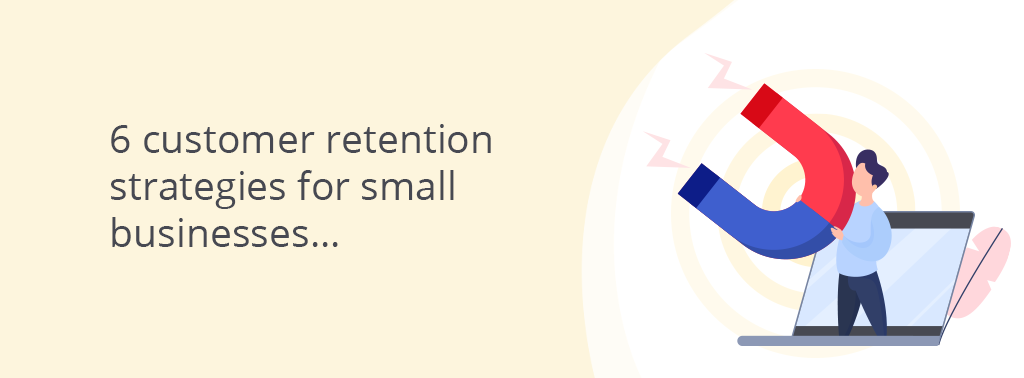For small businesses, every new customer is a small triumph of effective marketing. With this in mind, it is especially important to carefully plan how to keep customers loyal and maximise their lifetime value to the business. This guide sets out 6 customer retention strategies that could help keep customers coming back to your small business.

Loyalty schemes and insider benefits
Rewarding customers for their loyalty is a great way to incentivise repeat custom and so sits at the top of our list for customer retention strategies.
Businesses can use lots of different tactics to do this, including:
● Discounts
● Multi-buy offers
● Reward cards
● Access to members’ benefits such as discounts on another business’s products
● Perks such as seasonal gifts
● Entry into prize draws
Some types of business will come up with their most effective customer benefits by thinking outside the box. For example, customers could be allowed to visit “behind-the-scenes” areas of a business’s premises, or they could be given the opportunity to meet skilled team members.
After-sales support
After-sales support, also known as ‘after-sales care’ or ‘after-sales service’, means communicating with customers about their purchase, after the transaction has been completed.
The best way to deliver after-sales support varies depending on the type of product and brand. Commonly used options include:
● Direct mail, such as thank you cards or vouchers sent by post
● Calls via a customer service phone line to ensure the customer is having a good experience with the product
● Customer service emails teaching the customer how to get the most out of the product
The business should always get the customer’s advance consent to any of these methods of contact.
In some industries, such as software-as-a-service (SaaS), businesses do more in-depth after-sales support, through methods such as providing webinars and training sessions to help customers use the product to the best of its potential. This is especially common among companies offering subscription services.
Some forms of after-sales support require a significant investment of employee time. To ensure the return justifies this investment, businesses should track the value added by after sale care against the costs of providing it.
Telling the business’s story through marketing
Perhaps one of the more overlooked customer retention strategies. Help people love your brand and what you stand for.
Customers are much likelier to keep coming back to a business if they become interested in the business’s story. Think of how TV viewers keep watching shows because they start to care about what will happen to the characters. Businesses can achieve a similar effect through clever storytelling on their marketing channels.
Brand storytelling can take place on one of more channels, including social media platforms, email newsletters and blogging. The following topics are often covered by brand storytelling:
● Team members’ achievements
● How the business is responding to challenges
● Business milestones
● History of the business and its industry
● Business mission/philosophy
Elements like these can combine to give customers a stronger sense of a business’s identity. This breeds loyalty and repeat custom.
Personalisation
Personalisation has emerged as a key marketing concept in recent years. It means making marketing specific to each customer.

The more basic personalisation tactics are done via methods like mail merge, which can automatically edit marketing emails so that they use the customer’s name, rather than a generic salutation. According to the email marketing provider Campaign Monitor, customers are 26% more likely to open an email if the subject line is personalised.
More advanced personalisation tactics include tailoring the products which are advertised to a customer based on their purchasing history (Amazon has been doing this extensively for years), and optimising the sequence of marketing communications delivered to a customer according to their behaviour data. These techniques improve customer retention by making clever use of the information a business has about each customer. Businesses need to collect just the right data, while abiding by data protection regulations, in order to use personalisation to the full.
Identify the reasons for customer churn
Customer churn is the phenomenon of customers buying from a business, and then quickly exiting the business-customer relationship. This is the antithesis of customer retention, and for most small businesses, it’s something to be avoided.
We can sometimes identify the reasons for customer churn by looking carefully at customer behavioural data. For instance, if a business has an online shop, it might notice that returning customers often abandon their cart at a certain point during the sales process. Another way to uncover reasons for churn is customer feedback. A business might be told by multiple customers that they are unhappy with a certain aspect of a product that didn’t meet their expectations, or it might emerge that there has been a sticking point in the customer experience, such as slow delivery or unprofessional customer service.
Once a business has identified a likely reason for customer churn, it can take action to rectify the problem, or at least manage it through proactive after-sales care.
Targeting customers who seem likely to become repeat customers
Some customers are naturally more inclined than others to buy repeatedly from a business. This can result from a wide range of personal factors, including tendencies towards brand loyalty and habitual behaviour, lifestyle requirements, and how much money the customer has available to spend on the sort of products or services the business sells.
Businesses should be careful not to focus too heavily on certain customer groups at the expense of other groups. With that said, it makes sense for a business to target its marketing mainly towards customers who are likely to become repeat customers.
We can find out about the likelihood of customers buying repeatedly by comparing the average lifetime value of customers with different characteristics. For example:
● Use a website analytics software such as Google Analytics to compare the average lifetime value of customers who found the business via different sources (e.g. organic web search, paid search advertising, social media), or who are associated with different demographic groups (age, gender, interest).
● Do in-person customer surveys to find out how customers found out about the business, and how likely they are to buy again.
Finding the answers to questions like these provides a basis for targeting a business’s marketing towards likely repeat customers. Retaining customers becomes much easier when the business is targeting the customers who are most likely to be loyal.
So, now you have a few customer retention strategies to try and adapt to your business. Customer retention is just as important as trying to find new customers and often overlooked by small businesses. You can try using an 0800 number to increase enquiries, offering your customers a number that’s free to call removes any barriers to stop them picking up the phone.







